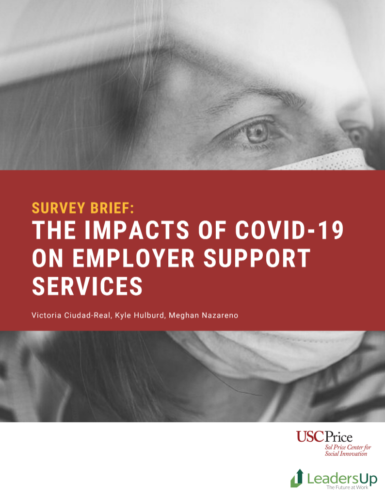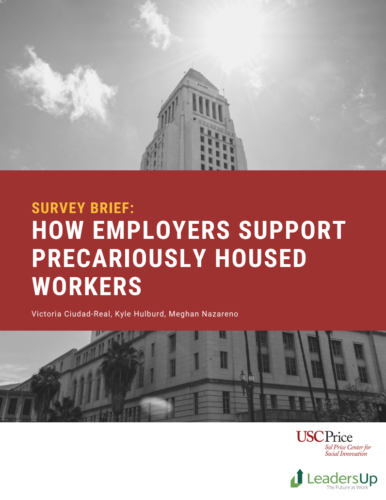The USC Sol Price Center for Social Innovation partnered with LeadersUp, a national nonprofit organization committed to bridging the divide to create an inclusive, antiracist economy, to launch the Accelerating Employment Strategies for the Precariously Housed project. This project aimed to address hiring and recruitment challenges among the precariously housed workforce by identifying employer-led solutions. By leveraging the expertise of employers, this project offers learnings across the “employment pipeline” for employers to engage in hiring and retention initiatives that expand employment opportunities for precariously housed individuals. The employment pipeline refers to the stages of hiring, retention, and long-term economic stability for job seekers.
This report outlines the findings from the project’s activities including an employer survey, Innovation Lab sessions, and case studies.
 Photo: iStock/Rawpixel Ltd
Photo: iStock/Rawpixel Ltd
KEY FINDINGS
- A significant portion of employers do not feel confident in their understanding of the unique barriers and needs of precariously housed jobseekers and employees. One way to bolster their understanding is to collaborate with organizations and resource centers that specialize in serving precariously housed populations.
- Strengthening systems coordination can facilitate access to resources for precariously housed employees and jobseekers at various intervention points. Systems coordination requires strategizing, planning, and reaching solutions across existing efforts in both regional housing and employment sectors to minimize duplicate efforts. Investing in the tools and resources needed to coordinate housing and employment strategies can benefit the hiring and retention of precariously housed workers.
- The COVID-19 pandemic gave rise to new challenges for hiring and retaining workforce talent, including those already experiencing housing precarity. Employers can adapt by approaching employment with empathy and adopting a culture of flexibility due to the challenges job applicants and employees may face outside of the workplace.
- Technology can provide advantages for hiring and recruiting new talent. For example, cell phones and text messaging job applicants can expand the opportunities for those looking for work. Additionally, both in-person and virtual resources can target a larger population of precariously housed job seekers attempting to expand their skill range or job market.
EMPLOYER ASSESSMENT TOOL
As an employer in Los Angeles and the greater Southern California region, you are likely employing people who are precariously housed. As such, it is important to understand how an employee’s challenges with housing precarity might be interfering with their employment, and by extension, their overall wellness and success. This employer assessment will provide you with customized resources to help you support employees experiencing housing precarity, and initiate conversations within your organization to build a more inclusive and sustainable workforce.
EXPLORE RELATED RESEARCH
MEET THE TEAM
Victoria Ciudad-Real
Project Manager, USC Sol Price Center for Social Innovation
John Roberson III
Chief of Staff, LeadersUp

Meghan Nazareno
Graduate Research Assistant, USC Sol Price Center for Social Innovation

Caroline Bhalla
Executive Director, USC Sol Price Center for Social Innovation

Kyle Hulburd
Graduate Research Assistant, USC Sol Price Center for Social Innovation

Gary Painter
Director, Homelessness Policy Research Institute
INCLUSIVE WORKFORCE DEVELOPMENT
The Price Center for Social Innovation, in partnership with LeadersUp, deploys social innovation frameworks to study inclusive workforce development. Projects aim to foster a more equitable economy through workforce development strategies that target marginalized workers and jobseekers. To address structural economic inequality, intimate community partnerships allow for innovative solutions to emerge through co-production models and design thinking methods. Related research has focused on:
- Fair Chance Hiring Among Los Angeles Employers
- Piloting Fair Chance Hiring Employment Strategies (forthcoming)
This partnership is made possible through generous funding from the State of California Workforce Accelerator Fund.
Stay Informed
If you would like to receive updates about our Fair Chance hiring work, please subscribe to our Newsletter in the footer below. If you have questions about this partnership, please contact Megan Goulding, Head of Strategy and External Relations at [email protected].





